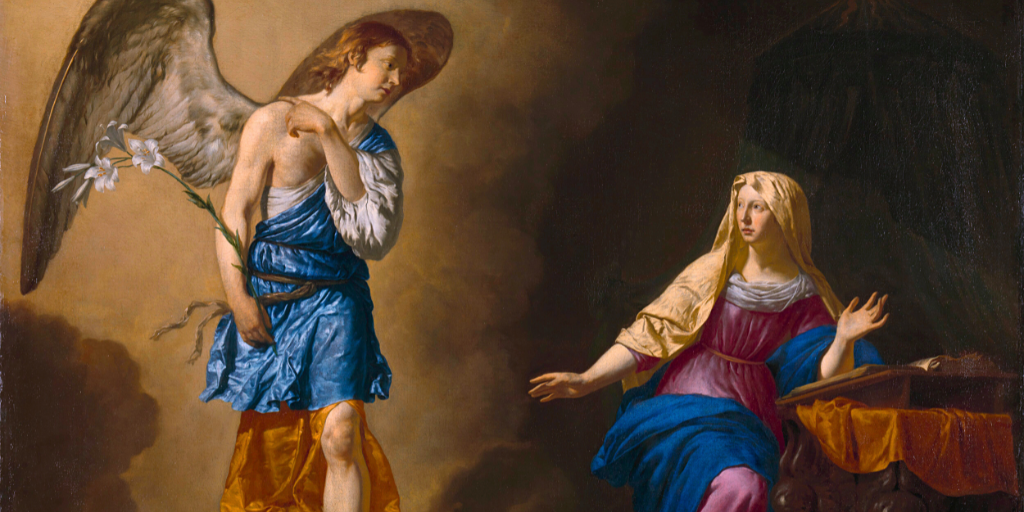
Sr. Margaret Kerry, FSP, discusses how Mary's yes to God brought us the Eucharist.
I wondered how many times the Bible invites us to food and drink. In my search, I found that the word “eat” is written 466 times, and drink is mentioned 452 times.
Since Mary was well-versed in the Scriptures she would have noticed these verses. Jesus used the same words in His invitations to us. Mary as our mother called to give birth to us in Christ paid attention knowing that we don’t live on bread alone in our need to be nourished by God’s Word. She heard Jesus tell his disciples, “I have eagerly desired to eat this Passover with you” (Luke 22) and knew something was going to change. Jesus had already mentioned that he was the living bread that came down from heaven (John 6:51). Imagine how astounded Mary was when she heard each apostle’s account of the Last Supper.

Mary's Yes Brought Us the Eucharist
Her “yes” brought us the Eucharist, Jesus’ flesh formed in her womb, the Word incarnate, giving himself until the end of time in the Paschal Mystery. Saint John Paul II said, “there is a profound analogy between the Fiat which Mary said in reply to the angel, and the Amen which every believer says when receiving the body of the Lord” (Ecclesia de Eucharistia, Chapter 6). Father Giuseppe Forlai writes,
Mary carried and nourished Jesus in her womb for nine months, and the Son, as he grew, began to carry the Mother in himself. Jesus made Mary the most perfect disciple by nourishing her with the word. Jesus thus "gave birth" to Mary! (Mary, Mother of the Apostles)
Mary is the prototype of every believer. She is the first dwelling of the Son. We are called to be dwellings of the Son so that it is no longer we who live but Christ (Gal. 2:20). Through baptism we are connected to the source and summit of Christian life, the Liturgy of the Word and Eucharist.
We need a blood transfusion.… There must be communication, union, between the heart of Jesus and our heart so that his divine blood will flow into us until little by little our blood is replaced by his. ... It is no longer I …. It is Jesus in me!” (Blessed James Alberione, Opera Omnia).

Mary and the Eucharist
For Mary, receiving the Eucharist must have somehow meant welcoming once more into her womb that heart which had beat in unison with hers and reliving what she had experienced at the foot of the Cross. (Saint John Paul II, Ecclesia de Eucharistia, Chapter 6)
We read in the Vatican II document Sacrosactum Concillium that liturgy builds us up to mature measure for the fullness of Christ’s Church, making of us a holy temple of the Lord, a dwelling-place for God in the Spirit. We participate in the salvific activity of our triune God (SC, 2). The paschal character of the liturgy, found in the transformation of the elements of bread and wine into the living Christ, is also about our transformation as partakers of His Body and Blood.
From the liturgy we are sent out to give birth to Jesus, Who gives birth to us, for our family, our neighborhood, our parish and all those we come in contact with. We are the “witnesses God had already chosen — us who ate and drank with him after he rose from the dead” (Acts 10:4). We eat and drink with Him at the table of His Body and Blood. Pope Francis said, “Christian faith is either an encounter with Him alive, or it does not exist.”
The liturgy guarantees us the possibility of such an encounter.
For us, a vague memory of the Last Supper would do no good. We need to be present at that Supper, to be able to hear his voice, to eat his Body and to drink his Blood. (Desiderio desideravi, 11).

Mary Stands By Our Side
“Behold, I stand at the door and knock. If anyone hears my voice and opens the door, I will come in to him and eat with him, and he with me.” (Revelation 3:20, ESV)
Mary stands by our side as we open this door to life by partaking in the Mass. She “can guide us towards this most holy sacrament, because she herself has a profound relationship with it” (John Paul II, Ecclesia de Eucharistia, Chapter 6).
Share your thoughts with the Catholic Mom community! You'll find the comment box below the author's bio and list of recommended articles.
Copyright 2024 Sr. Margaret Kerry, FSP
Images: Canva
About the Author

Sr. Margaret Kerry, fsp
A Daughter of St. Paul for 40 years Sr. Margaret continues to pursue new ways to proclaim the Gospel: sharing the Pauline Charism with the laity, writing books (St. Anthony of Padua: Fire & Light; Strength in Darkness: John of the Cross; Prayers for the New Evangelization), & through direct evangelization. She is available for workshops on the Vocation & Mission of the Laity, Media Literacy, and The New Evangelization. mkerry@paulinemedia.com


.png?width=1806&height=731&name=CatholicMom_hcfm_logo1_pos_871c_2728c%20(002).png)
Comments